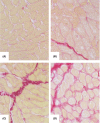Atrial fibrillation in aging population
- PMID: 31942483
- PMCID: PMC6880740
- DOI: 10.1002/agm2.12015
Atrial fibrillation in aging population
Abstract
With aging, the pathogenesis processes of atrial fibrillation (AF) are heightened. In this article, we review the mechanisms that predispose elderly patients to AF. We also highlight the unique features in diagnosis, stroke prevention, and treatment strategies for the elderly patient with AF.
Keywords: aging; arrhythmia; atrial fibrillation.
© 2018 The Authors. Aging Medicine published by Beijing Hospital and John Wiley & Sons Australia, Ltd.
Conflict of interest statement
The authors declare no potential conflicts of interest.
Figures


References
-
- Lakshminarayan K, Solid CA, Collins AJ, et al. Atrial fibrillation and stroke in the general Medicare population: a 10‐year perspective (1992 to 2002). Stroke. 2006;37:1969‐1974. - PubMed
-
- Go AS, Hylek EM, Phillips KA, et al. Prevalence of diagnosed atrial fibrillation in adults: national implications for rhythm management and stroke prevention: the Anticoagulation and Risk Factors in Atrial Fibrillation (ATRIA) study. JAMA. 2001;285:2370‐2375. - PubMed
-
- Yoshizawa T, Niwano S, Niwano H, et al. Prediction of new onset atrial fibrillation through P wave analysis in 12 lead ECG. Int Heart J. 2014;55:422‐427. - PubMed
-
- Li Q, Liu X, Wei J. Ageing related periostin expression increase from cardiac fibroblasts promotes cardiomyocytes senescent. Biochem Biophys Res Comm. 2014;452:497‐502. - PubMed
Publication types
LinkOut - more resources
Full Text Sources
